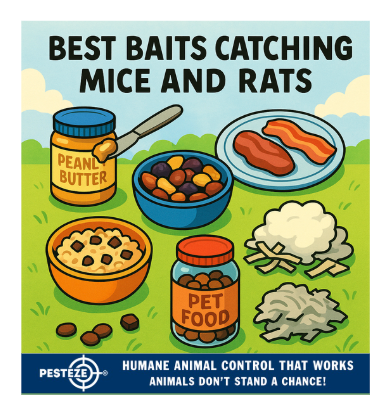BEST BAITS FOR CATCHING MICE AND RATS

BEST BAITS FOR CATCHING MICE AND RATS
SUMMARY
This guide lists the most effective, commonly used baits for mice and rats and explains why they work. It also covers placement, handling, safety around pets/children, and humane considerations so you trap effectively without creating new hazards.
FEATURES
-
Peanut Butter: High-fat, aromatic — excellent for both mice and rats.
-
Dried Fruit & Nuts: Especially attractive to rats; long-lasting and easy to use.
-
Meat & Bacon: Strong-smelling and very tempting to rats (less so for mice).
-
Oats, Cereal & Chocolate: Good alternatives for picky rodents.
-
Pet Food & Dog/Cat Kibble: Effective, but keep away from pets.
-
Non-food Options: Cotton or shredded paper can lure nesting mice (for monitoring).
GUIDE DESCRIPTION
Choosing the right bait makes a big difference. Rodents forage by scent and quickly learn which food sources are reliable. Peanut butter is the single most commonly recommended bait because it’s sticky (hard to steal without triggering a trap), aromatic, high in fat, and appealing to both mice and rats. A pea-sized smear is often enough — too much and rodents can remove it without triggering the mechanism.
Rats are larger and have broader palates than mice. They’re often attracted to strong-smelling, high-protein baits like bacon, cooked meat scraps, or oily foods. Dried fruit (raisins, apricots), nuts, and peanut butter work well for rats too. Because rats may be suspicious, offer small test portions on multiple nights to build confidence before setting traps in earnest. For mice, oats, cereal, chocolate, and peanut butter are reliable. Mice may also take bits of soft bread or melted cheese, though “cheese” is less universally appealing than many people expect.
Placement and presentation matter as much as bait choice. Put bait on the trigger mechanism (or inside a live-capture trap) rather than just nearby. Use small amounts — a little is often more effective. Wear gloves when handling bait and traps to avoid transferring your scent; rodents can be wary of strong human odors. Anchor or secure bait in place if you’re worried about rodents stealing it without setting the trap. Rotate baits if you see little interest; rodents can be finicky or may switch preferences seasonally.
Safety and humane practice are essential. Always use tamper-resistant bait stations or place traps where pets and children cannot access them. Avoid leaving edible baits out in open areas. If you use live-capture traps, check them at least twice daily and follow local guidance about release (relocation is illegal in some areas). If carcasses are found (from lethal traps), handle them with gloves and dispose of them according to local rules; disinfect trap sites to reduce disease risk.
Finally, baiting is only one part of control. Combine baited trapping with exclusion (sealing entry points), sanitation (remove food sources), and monitoring. For large infestations, persistent captures, or if pets/children are at risk, call a licensed pest-control professional to implement a safe, effective Integrated Pest Management (IPM) plan.
- Saneeth Thota


Comments 0